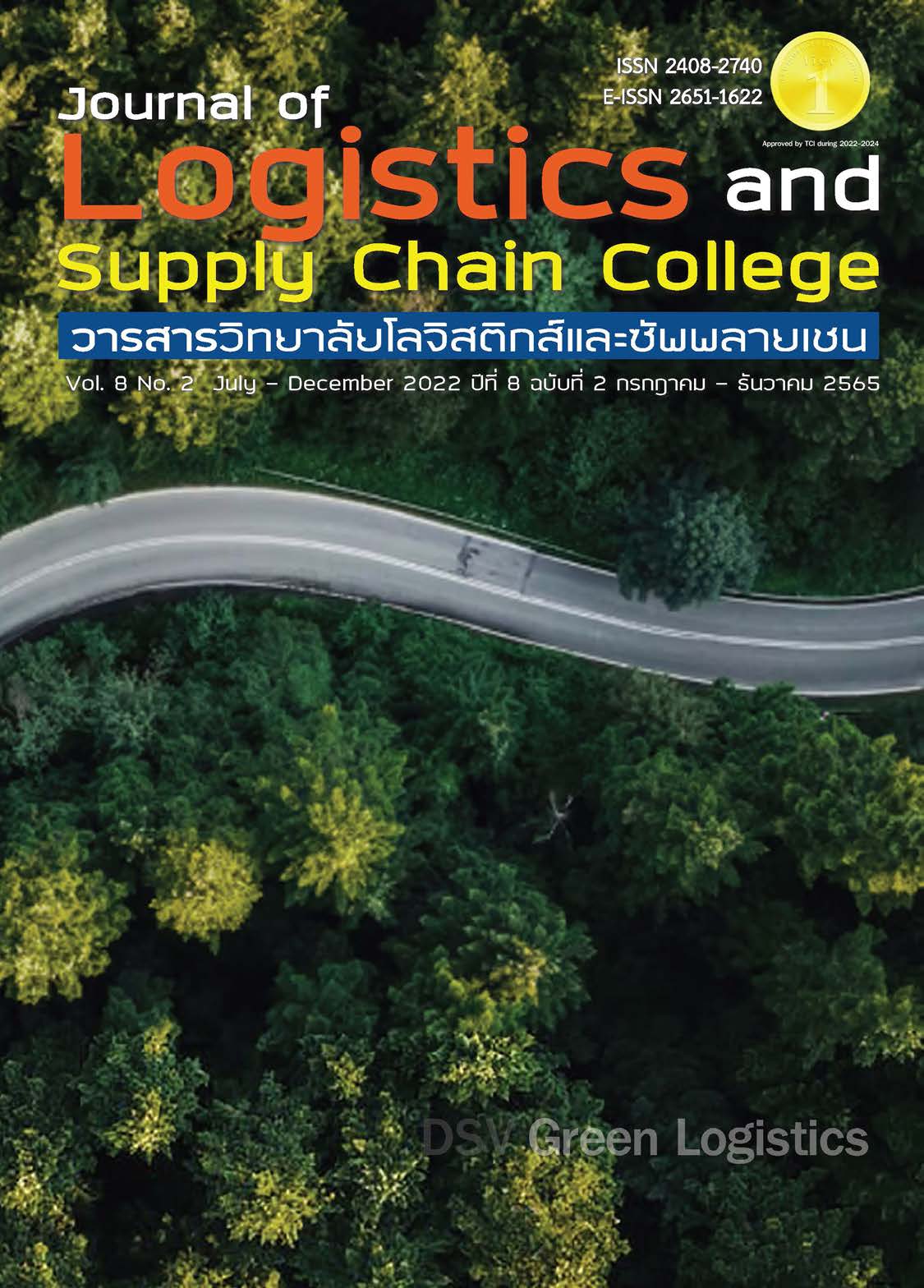Marketing Mix Factors Affecting Online Shopping Behavior of Consumers in Muang District Nakhon Pathom Province
Keywords:
Marketing Mix, Shopping Behavior, Online MediaAbstract
The objective of this research is 1) to study the demographic factors affecting the shopping behavior via online media in Muang District Nakhon Pathom Province and 2) to study the opinion level on marketing mix factors affect the shopping behavior via online media of consumers in Muang District Nakhon Pathom Province, consisted of 374.840 people, 400 samples. The data was collected by questionnaires with content validity and reliability. The data analysis consisted of descriptive statistics; frequency, percentage, mean, and standard deviation. Inferential statistics include Chi-square and Multinomial logistic regression analysis. The research results found that 1) most respondents were female, aged 21 - 25 years, have a bachelor's degree or equivalent, occupation student, work experience less than 1 year and average monthly income less than 15,000 baht. Most of the online media used to buy was Facebook. There was a shopping behavior 1-2 times per month. The level of the purchase price each time was less than 1,000 baht 2) the opinion level on marketing mix factors that most affected behavior in online media shopping of consumers in Muang District Nakhon Pathom Province was distribution channels (4.21), followed by products (4.00), promotions (4.00), and price (3.95) respectively. These research results can be used as a guideline for the improvement plan of online media distributors to meet customer needs and achieve business goals.
References
กรมประชาสัมพันธ์. (2564). ไทยคว้าอันดับ 42 ของโลกในการจัดอันดับ B2C e-Commerce Index 2020 ครองอันดับ 3 อาเซียน. ค้นเมื่อ 29 กันยายน 2564, จาก: https://www.prd.go.th/th/content/category/detail/id/39/iid/12253.
กมลชนก ก้าวสัมพันธ์ และปะราสี อเนก. (2560). ปัจจัยส่วนประสมทางการตลาดที่มีผลในการตัดสินใจซื้อผลิตภัณฑ์อาหารเสริมประเภทบำรุงร่างกายของผู้บริโภคในเขตอำเภอเมือง จังหวัดเชียงใหม่. วารสารบัณฑิตวิจัย, 8(2), 183-198.
เกตุวดี สมบูรณ์ทวี . (2560). ความสัมพันธ์ระหว่างปัจจัยทางการตลาดกับความจงรักภักดีต่อร้านกาแฟสดในเขตกรุงเทพมหานคร. คณะวิทยาการจัดการ, มหาวิทยาลัยศิลปากร วิทยาเขตสารสนเทศเพชรบุรี.
ชิตพงษ์ อัยสานนท์. (2559). Marketing Logistics โลจิสติกส์ในการตลาดหรือการตลาดในโลจิสติกส์. ค้นเมื่อ 29 กันยายน 2564, จาก: http://www.thailandindustry.com/onlinemag/view2.php?id=1334§ion=5&issues=80.
เชาวลิต เหมะธุลิน. (2557). การหาค่าความเที่ยงตรงเชิงเนื้อหา IOC. ค้นเมื่อ 30 กันยายน 2564, จาก: http://chaovalit2555.blogspot.com.
ชูชัย สมิทธิไกร. (2554). พฤติกรรมผู้บริโภค. กรุงเทพฯ: สำนักพิมพ์แห่งจุฬาลงกรณ์มหาวิทยาลัย.
ฐาปนา บุญหล้า และนงลักษณ์ นิมิตภูวดล. (2555). การจัดการโลจิสติกส์: มิติซัพพลายเชน. กรุงเทพฯ: ซีเอ็ดยูเคชั่น.
ธงชัย สันติวงษ์. (2554). พฤติกรรมบุคคลในองค์การ. กรุงเทพฯ: เจริญพัฒน์.
ธนิดา อัศวโยธิน. (2561). การตลาดออนไลน์ที่มีผลต่อพฤติกรรมการซื้อสินค้าออนไลน์ของผู้บริโภค ในเขตอำเภอเมือง จังหวัดนครราชสีมา. ค้นเมื่อ 30 กันยายน 2564, จาก: http://www.baabstract.ru.ac.th/AbstractPdf/2561-5-7_1565850078.pd.
ปฐณวิกรณ์ ฐิตาภัทรภิญโญ, พุฒิธร จิรายุส และภัสสิรี วรเวชธนกุล. (2564). ปัจจัยส่วนประสมทางการตลาดออนไลน์ที่มีผลต่อการตัดสินใจซื้อสินค้าจากร้านโชว์ห่วยผ่านทางแอปพลิเคชัน Shopee. วารสารมนุษยศาสตร์และสังคมศาสตร์ มหาวิทยาลัยเอเชียอาคเนย์, 5(2), 96-117.
ปัทมา ตุงคะเสรีรักษ์ และไพรพันธ์ ธนเลิศโศภิต. (2563). ปัจจัยส่วนประสมทางการตลาดที่มีผลต่อการตัดสินใจซื้อสินค้าในตลาดชุมชนของผู้บริโภคในอำเภอเมืองลำพูน จังหวัดลำพูน. วารสารบริหารธุรกิจและศิลปศาสตร์ ราชมงคลล้านนา, 8(2), 13-32.
มาริษา สุจิตวนิช และดวงใจ คงคาหลวง. (2563). แนวทางการสื่อสารการตลาดผ่านสื่อสังคมออนไลน์ในกลุ่มเจเนอเรชันเน็ต. วารสารวิชาการร้อยแก่นสาร, 5(2), 152-166.
วศิน อุ่ยเต็กเค่ง. (2558). การศึกษากลยุทธ์การสื่อสารทางการตลาดออนไลน์รูปแบบสตรีมมิ่งในประเทศไทย. การค้นคว้าอิสระ หลักสูตรนิเทศศาสตรมหาบัณฑิต สาขาวิชาการสื่อสารการตลาดดิจิทัล, มหาวิทยาลัยกรุงเทพ.
ศิริวรรณ เสรีรัตน์, ปริญ ลักษิตานนท์ และศุภร เสรีรัตน์. (2552). การบริหารการตลาดยุคใหม่. กรุงเทพฯ: บริษัท ธรรมสารจำกัด.
ศิริลักษณ์ สุวรรณวงศ์. (2553). ความรู้สถิติเบื้องต้นสำหรับการออกแบบสอบถาม. ค้นเมื่อ 30 กันยายน 2564, จาก: https://ruchareka.wordpress.com/2010/05/15/.
สมเกียรติ ภู่พัฒน์วิบูลย์. (2564). ปัจจัยส่วนประสมทางการตลาดออนไลน์และความภักดีของลูกค้า: ข้อมูลป้อนกลับจากบทรีวิวโดยลูกค้าลาซาด้า. วารสารวิจัยวิทยาการจัดการ มหาวิทยาลัยราชภัฏสุรินทร์, 5(2), 88-102.
สำนักงานสถิติแห่งชาติ. (2563). การสำรวจการมีการใช้เทคโนโลยีสารสนเทศ และการสื่อสารในครัวเรือน พ.ศ. 2563. กองสถิติเศรษฐกิจ สำนักงานสถิติแห่งชาติ.
สำนักงานสถิติแห่งชาติ. (2564). การสำรวจการมีการใช้เทคโนโลยีสารสนเทศ และการสื่อสารในครัวเรือน พ.ศ. 2564. กองสถิติเศรษฐกิจ สำนักงานสถิติแห่งชาติ.
เสาวนีย์ ศรีจันทร์นิล. (2559). ส่วนประสมทางการตลาดออนไลน์ที่มีผลต่อการตัดสินใจซื้อผลิตภัณฑ์ผ่านทางอินเทอร์เน็ตของผู้บริโภค ในเขตจังหวัดนนทบุรี, มหาวิทยาลัยราชพฤกษ์.
อรพิน ภิรมย์. (2559). การใช้ปัจจัยส่วนประสมการตลาดในการตัดสินใจซื้อเสื้อผ้าแฟชั่นของผู้บริโภคในเขตบางเขน กรุงเทพมหานคร. สารนิพนธ์หลักสูตรบริหารธุรกิจมหาบัณฑิต บริหารธุรกิจ, มหาวิทยาลัยเกริก.
อัญชลี หล่อนิล และจันทิมา เขียวแก้ว. (2562). การใช้สื่อสังคมออนไลน์เพื่อการสื่อสารการตลาดในกลุ่มธุรกิจผู้เลี้ยงกระบองเพชร. ค้นเมื่อ 1 ตุลาคม 2564, จาก: file:///C:/ Users/DELL/Downloads/1425-Article%20Text-3333-1-10-20200121.pdf.
Ajzen, I. (1991). The Theory of Planned Behavior. Organizational Behavior and Human Decision Processes, 50, 179-211
Belch, George E. & Michael A. Belch. (2005). Advertising and promotion: an integrated marketing communications Perspective. (6th ed.) Boston: McGraw-Hill.
Duffett R. G. (2017). Influence of social media marketing communications on young consumers’ attitude. Emerald Publishing Limited. Young Consumers. 18(1), 19-39.
Gilbert, D. Harrell. (2009). Consumer Behavior. (9th ed). Michigan: Harcourt Brace Jovanovich.
Hanna, N & Wozniak, R. (2001). Consumer behavior: An applied approach. Upper Saddle River. NJ: Prentice Hall.
Yang, Hongwei, Liuning Zhou & Hui Liu. (2011). Predicting young Chinese consumers’ mobile viral attitudes, intents and behavior. Asia Pacific Journal of Marketing and Logistics, 24(1), 59-77.
Kotler, P. (2000). Marketing Management. The Millennium Edition. Pearson Prentice Hall: Upper Saddle River, NJ Publisher.
Kotler, P. (2009). Marketing Management. (13th ed.). Pearson Prentice Hall: Upper Saddle River, NJ Publisher.
Li, R., Kim, JJ., & Park, JS. (2007). The Effects of Internet Shoppers’ Trust on Their Purchasing Intention in China. Journal of Information Systems and Technology Management, 4(3), 269-286.
Pietro, L.D. & Pantano, E. (2012). An empirical investigation of social network influence on consumer purchasing decision: The case of Facebook. Journal of Direct, Data and Digital Marketing Practice, 14(1), 18-29.
Schiffman, L. G. & Leslie Lazar Kanuk. (2000). Consumer Behavior. (5th ed.). New Jersey: Prentice –Hall, Inc.
Seer, L. & Avornicului, MC. (2015). The effect of product perception, shopping experience, and information access on the buying intention of online customers. Forum on Economics & Business, 18(125), 98-123.
Stock, James R. & Lambert, Douglas M. (2001). Strategic Logistics Management. (4th ed.). New York: McGraw-Hill Companies, Inc.
Wu, W.Y., Lee, C.L., Fu, CS., & Wang, H.C. (2013). How can online store layout design and atmosphere influence consumer shopping intention on a websites. International Journal of Retail & Distribution Management, 42(1), 4-24.
Yamane, Taro. (1976). Statistics: An introductory analysis. (2nd ed.). New York: Harper and Row.



